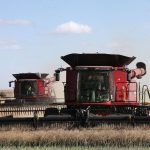Building and expanding | President suggests ‘very considerable investments’ in the works
The grain company that helped usher in an era of elevator consolidation in Western Canada has a new vision that includes new construction.
“We are going to invest in our network,” Kyle Jeworski, president of Viterra North America, said during a presentation he delivered at Ag West Bio Inc.’s annual meeting.
“We will be very active in Western Canada and we’ll also be active in the U.S.”
In an interview following his presentation, Jeworski elaborated on how investment capital will be deployed in Western Canada.
Read Also

Agriculture ministers agree to AgriStability changes
federal government proposed several months ago to increase the compensation rate from 80 to 90 per cent and double the maximum payment from $3 million to $6 million
“We’re looking at investments from greenfield operations, so brand new locations to facility ex-pansion.”
The company’s last major investment initiative, 1997’s Project Horizon, saw the construction of 22 inland terminals and the closure of 235 wooden grain elevators at 170 locations across the Prairies.
It has been a long time since any grain company has talked about expanding its elevator network.
Jeworski, who took over the reins at Viterra in January, said the company will be spending more on its network of 65 elevators than it has in the past.
“We need to make sure that we adjust our network to match the changing needs of our farmer base,” he said.
Investments will vary by location. The expansion efforts will include increasing storage capacity, boosting rail car spots, improving receiving and loading speeds, installing new cleaners and dryers and en-hancing overall efficiency.
The first in what will be a series of investments was made May 15 when Viterra announced it was spending $20 million to upgrade four of its Saskatchewan terminals in White Star, Humboldt, Waldron and Ituna.
“You’ll see some of our further announcements in the near future. I expect these to be very considerable investments.”
He said the world grain stocks-to-use ratio has been getting tighter since the late 1990s and there is no end in sight to rising grain demand.
The United Nations’ Food and Agriculture Organization is forecasting huge growth in protein consumption around the world, which means more crops being fed to livestock.
For instance, the FAO predicts a 121 percent increase in protein consumption in South Asia between 2000 and 2030.
“It’s painting the ultimate bullish picture. Am I that far over in this bullish scenario? No, I’m not,” said Jeworski.
“You cut some of these forecasts in half and we’re still talking phenomenal growth, which has to be supplied with agricultural products.”
Viterra has more access to working capital now that it is owned by Glencore Xstrata, one of the world’s largest natural resource companies.
More capital will also be available because of the divestiture of its crop input and bulk fuel business.
The Competition Bureau recently approved Agrium Inc.’s acquisition of 217 of Viterra’s retail stores.
“That’s going to be a fundamental shift in the industry,” said Jeworski.
“By my rough calculation, there will be about 75 percent of the ag retail industry that will not be tied to grain related assets.”
What remains of Viterra’s Canadian assets are the grain elevators, 10 special crops processing plants, six port facilities and one canola processing plant.
The canola plant in Ste. Agathe, Man., which is small by industry standards, produces non-genetically modified expeller-pressed canola oil for specialty markets in North America.
The company also owns three special crops facilities and two dry pasta manufacturing plants in the United States and a variety of assets in other parts of the world.
Jeworski said Viterra is now a streamlined grain company with one primary focus.
“We’re really a company of logistics, logistics, logistics,” he said.
There is a huge emphasis on properly managing inbound and outbound gain movement.
One of the biggest advantages of being a wholly owned division of Glencore Xstrata is having access to its logistical expertise.
“We have an in-house chartering group that I think is unparalleled.”
Glencore has more than 600 ocean vessels that it manages in-house.
“What does that mean for me sitting in Saskatoon, Sask., Balgonie, Sask., Wilkie, Sask.? That means better logistics, better planning, better flow through the system,” he said.
Jeworski said Viterra still has regional autonomy and operates much as it did before with elevators being run by the same managers.
And something else about the company hasn’t changed.
“Probably the number one question I get is, ‘are you still Viterra? What are you guys?’ he said.
“We’re very proud of Viterra. We’re proud of our history.”


















